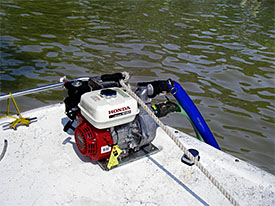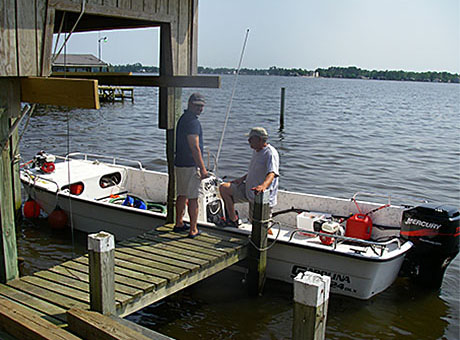
East Carolina University 2007 Field School
in Underwater Archaeology
22 May 2007
By Nadine Kopp
Today we began our first day on site for the summer field school. We were prepared the previous day for going out into the field by a brief orientation about the site followed by a mapping activity to refresh our memories on how to record a site using the baseline and offset method. We then practiced using the goniometer on a model of a ship’s frame and planking as we would be using this instrument to record the vessel’s lines. In this way we would be familiar with these techniques, as these procedures would be complicated underwater not only by our reduced ability to communicate between team members but also the water in which we would be working would be very low visibility. After a brief slide show of the sites that we would be looking at over the course of the next few weeks as well as examples of other regional craft, we began loading the vans with all the necessary equipment before heading out to the Washington Park site.

The dredge motor: the blue hose supplies water from the green intake hose to the dredge head to create the necessary suction to move the sediment.
As we started this task early we remained on schedule despite several minor setbacks. We loaded all our personal dive equipment into the vans, followed by boxes of gear, such as equipment for setting up the baseline, and then the dredge hoses and head. The plan was to dredge the stern post area of the site in order to satisfy some questions that emerged from the fall field school. Once all the equipment was loaded, the first van with Adam, Mel, Jeremy, and Steve went to get gas to operate the boat as well as the dredge while the other with Dr. Stewart, Calvin, Michelle and I went purchase some final necessary supplies, such as a fire extinguisher for the boat. On our way to the store there were several calls back in forth between the vans in search of the missing dredge pump equipment. Without this we would not be able to operate the dredge. As there were not many places that it could be located a second search in the storage locker produced the missing box, hidden on an upper shelf. Arrangements proceeded smoothly until we went to pick up the ECU boat Flounder. The simple task of attaching the trailer to the van proved to be quite problematic due to a hitch issue. After several attempts, curses, and loud banging noises, the trailer was finally secure.

Calvin and Dr. Babits monitor Flounder: the dredging headquarters for the Washington Park Site.
We then proceeded to Washington. Our van stopped at the boat launch and then we drove the rest of the way by water to the site, where we would meet the others. As it was a sunny warm day it was a great day to be out on the water, unfortunately it was a very short boat trip to the site from the launch location. When we arrived the others were already there. We unloaded all the gear and set up our dive equipment. We began by taking a short tour of the site so that we had an idea of what we would be working on for the next few days. The advantage of this site was that it is only located in about three to five feet of water, rendering communication easy by simply standing up. Once Dr. Stewart located the stem, we followed along the keel underwater to see the extent of the site. “Seeing” is a bit of an overstatement as the visibility today was particularly bad, but we did get a good feel for the site. We proceeded slowly in order to avoid any projecting timbers upon which we might snag our gear, such as the centerboard. Once we reached the stern post, our brief introduction to the site allowed us to continue with the rest of our activities.
The first necessary task was to set up a baseline. Adam instructed Mel and Steve in this process. This was accomplished by hammering several long pieces of rebar into the bottom slightly forward of the stem and slightly aft of the stern. These would serve as strong anchor points for the steel cable that was mounted around these. The steel cable stretched the length of the vessel and was tightened with a come-along to ensure stability.
While they were setting this up, Michelle taught Jeremy and me how to use the dredge. The dredge was set up on the boat next to the dock. First we attached a long hose to the dredge head with the other end attached to the motor. This would push water into the dredge creating the suction needed for moving the sediment. Then we attached another pipe to the motor; the end of this pipe was simply placed in the water as this was the intake pipe. The dredge head was run out to the location in which we would be dredging, avoiding kinks in the water line. I volunteered to get in the water first with Michelle to learn how to operate the dredge, while Jeremy stayed up top to ensure it was functioning properly. As this area had been dredged in the fall, there was no need to have a screen on the end of the dredge hose to sift dredge spoil and we simply positioned the end of the hose away from the site and current. Michelle located the stern post and began dredging, while I observed. With what little visibility there was I could see that she had placed one hand to slightly cover the dredge while the other fanned the sediment in the direction of the dredge head to be picked up by the suction. After her demonstration, it was my turn to begin dredging. I took over from where Michelle left off and dredged around the stern area for approximately a half hour. Although Michelle told me that this might be a tedious job, I found it rather interesting. This was my first real experience with underwater archaeology. I was uncovering a vessel from the past in the hopes of answering questions about its design and function. These thoughts bestowed a sense of exhilaration and anticipation to my brief use of the dredge. Hopefully this feeling will sustain me through a full day of dredging tomorrow!
Please feel free to contact us at mua@keimaps.com with any comments, questions, or suggestions during the weeks to come.
Return to Project Journal home page.

